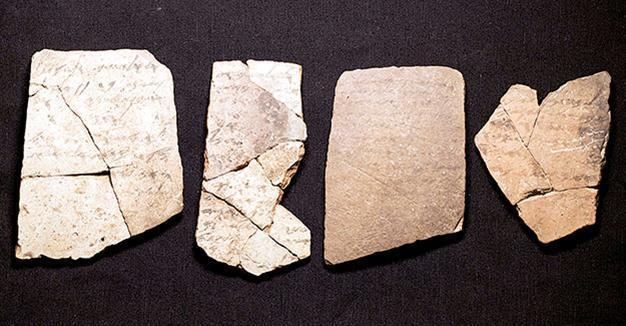Handwriting study finds clues on when biblical texts written
JERUSALEM - Associated Press
 Israeli mathematicians and archaeologists say they have found evidence to suggest that key biblical texts may have been composed earlier than what some scholars think.
Israeli mathematicians and archaeologists say they have found evidence to suggest that key biblical texts may have been composed earlier than what some scholars think.Using handwriting analysis technology similar to that employed by intelligence agencies and banks to analyze signatures, a Tel Aviv University team determined that a famous hoard of ancient Hebrew inscriptions, dated to around 600 BC, were written by at least six different authors.
Although the inscriptions are not from the Bible, their discovery suggests there was widespread literacy in ancient Judah at the time that would support the composition of biblical works.
The findings contribute to a longstanding debate about when biblical texts first began to be compiled: Did it take place before or after the Babylonian siege and destruction of Jerusalem in 586 BC and the exile of its inhabitants to Babylon?
In recent years, many scholars have attributed the composition of a group of biblical texts, from the Book of Joshua to the second Book of Kings, to the period after the siege, according to Israeli archaeologist Israel Finkelstein, who participated in the study. That theory holds that the biblical texts were written as a result of the exile to Babylon, when the composers began to think about their past and put their history to parchment.
Finkelstein, however, said he has long believed those texts were written in the late 7th century BC in Jerusalem, before the siege. He said the study offers support for that theory.
“It’s the first time we have something empirical in our hands,” said Finkelstein.
The team, made up of doctoral students in applied mathematics, math professors, archaeologists and a physicist, examined 16 ink inscriptions on ceramic shards discovered at the site of an ancient military fortress in Arad in southern Israel.
It used multispectral imaging to reconstruct Hebrew letters that had been partially erased over time, and then used a computer algorithm to analyze the writings to detect differences in handwriting strokes.
The tone of the inscriptions, which suggest they were not written by professional scribes, combined with the fortress’ remote location, indicate a wide spread of literacy at the time, according to the study.
















